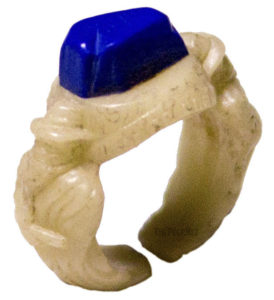
During radio’s heyday, it seems like every radio show was giving something away. It may have cost you a cereal boxtop or the inner seal from a jar of Ovaltine. Sometimes it cost a nickel or a dime… other times the only cost was that boxtop. Sometimes it was aimed at Mom; perhaps a cookbook or photo album. Rarely was it aimed at Dad. It was the kids at which most radio mail-away premiums were intended. And that was true of even The Shadow, perhaps not a show that kids should have listened to.
In the fall of 1941, at the beginning of the new season, the sponsors of The Shadow, the DL&W Coal Co., makers of Blue Coal, decided to offer a mail-away premium, and it was aimed squarely at kids. But they figured they could reach their customers, the purchasers of household heating coal, by going through the kids. Now maybe kids weren’t supposed to be listening to this shuddery fare, but they all knew (wink, wink) that kids were part of the audience.
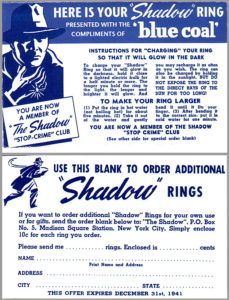
The ring was first offered on the fifth episode of the new season, “The Ring of Light,” broadcast on Nov. 23, 1941. The producers took a pre-existing unaired script titled “The Circle of Light” and modified it slightly so it would feature a ring much like the one they were about to offer. Having the ring become part of the story was a time-honored tradition in old radio, and made the mail-away item more desirable.
For only a dime!
The ring that kids received in 1941, known among collectors today as the “Blue Coal Ring,” cost a dime and was cast of white glow-in-the-dark plastic, and featured a blue lump of plastic “coal” on top signifying the sponsor’s product. On the base of the ring were images of The Shadow — the pulp Shadow, complete with cloak and .45 automatic — imprinted upon the sides. That’s somewhat ironic since it was the pulp version of The Shadow that was known for his cloak and .45 automatics, not the radio version.
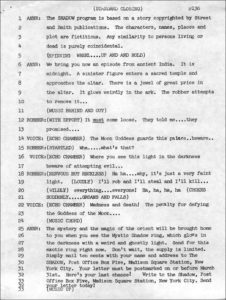
Read how it was advertised on the March 8, 1942, broadcast, “Death for a Messenger”. The Shadow intoned his famous closing, “The weed of crime bears bitter fruit. Crime does not pay. The Shadow knows!” And then, what followed was a short playlet, lasting all of a minute. But it really fired up the kiddies to cajole, beg and plead with their parents to order one of these swell rings for them. Click on the script page to make it a larger, readable size.
The ring was available for most of the rest of the 1941 season, the offer ending on March 31, 1942. After that, no further mention was made of the ring with the “grim, eerie glow.”
The Carey Salt ring
In 1947, a ring that is often called the “Carey Salt Ring” was offered by the alternate sponsor, Carey Salt. On the radio show, however, it was referred to as the “Shadow Magic Ring.” Here’s the middle commercial from the last Shadow broadcast of the 1946-47 season… the last chance to get your very own ring!
Well, kids, this is it. The final announcement of that exciting offer from makers of Carey Salt. Carey’s wonderful Magic Shadow Ring. Listen. You’ve never seen a ring like it. No ordinary ring can do what the Magic Shadow Ring does. It drinks in the living light as greedily as the jungle orchids eat live meat. Then you wear the ring in a dark room and — wow! — it glows with a weird, spooky radiance. Think of the fun you can have, amazing everybody and giving secret signals with your mysterious Magic Shadow Ring. It’s too good to miss, so you’d better hurry. Here’s all you do.
Tell Mom you need the white star from the top of a round package of Carey Salt, plain or iodized. Mail that white star and five cents — just a nickel — to Carey Salt, Hutchison, Kan. Or you can mail the sales slip from any Carey Salt product and five cents. Don’t forget to print your name and address plainly. Your Magic Shadow Ring will come postpaid. Act quickly before these thrilling rings are all gone. Remember, send five cents and either that Carey Salt white star or the sales slip from any Carey product. Address Carey’s, C-A-R-E-Y-S, Carey’s Salt, Hutchinson, Kan.
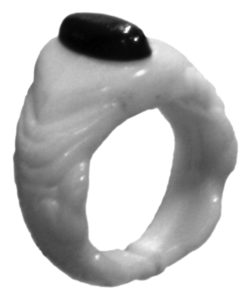
The unique thing about this ring is that the molds for the plastic ring had been used twice previously for rings offered by Jack Armstrong and Buck Rogers. It was originally designed for the Jack Armstrong show in 1940 and featured a green “stone” on a creamy white glow-in-the-dark base. The base of the ring had two crocodiles on it, each facing upward, mouth open, to hold the colored plastic stone. Kids wearing this ring could imagine themselves wading through African swamps, fighting off crocodiles just like those on the ring.
In 1945, Post Corn Toasties used the same molds and released a new version of the ring with a red “stone” replacing the green one. This became the Buck Rogers “Ring of Saturn,” and was given away on the daily quarter-hour show. Yes, the same molds and the same glow-in-the-dark plastic for the ring base. Only the color of the “stone” changed. But kids, being a gullible bunch, didn’t notice… or if they did, they didn’t complain. After all, it glowed in the dark!

Then in 1947, the Carey Salt Co. used the molds one last time. Being on a budget, so it reused the ring molds, originally designed for Wheaties and Jack Armstrong, changing the plastic “stone” to black and giving it away on The Shadow’s radio show.
Don’t you suppose kids who sent away for the Buck Rogers ring or The Shadow ring were puzzled by the crocodiles? While they were certainly appropriate for the Jack Armstrong “Dragon’s Eye” ring, they had nothing to do whatsoever with Buck Rogers or The Shadow. But if these youngsters had also sent away for the Jack Armstrong ring seven years previously, they would have understood. I guess kids didn’t give it much thought in those days. And after the passage of seven years, the original owners of the Jack Armstrong ring had grown up and likely weren’t about to send in for a kids’ ring. For kids in the 1947 audience, it was a really cool-looking ring, and it glowed in the dark; that’s what mattered.
If you would like a more detailed account of the glow-in-the-dark rings offered by The Shadow, I can heartily recommend the ultimate guide to the radio Shadow: The Shadow: The History and Mystery of the Radio Program, 1930-1954 written by Martin Grams Jr. Check out pages 334-336 for his excellent history of The Shadow’s rings.
Other premiums?
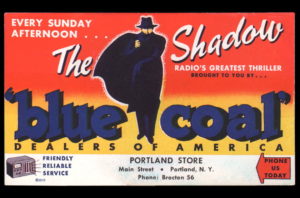
So, were there any other radio-related premiums from The Shadow, you may ask? No. And that does seem strange, since so many other radio programs offered recipe books, distance finders, all variety of rings, photo albums, decoders, pins, badges, movie viewers, telescopes, belts, compasses, whistles and so, so many other wonderful things to attract and hold listeners. The two rings were the only mail-away premiums ever offered by The Shadow on the radio. Perhaps the reason lay in the fact that The Shadow was not really considered a kid’s show, and those were the types of shows that offered the most mail-away premiums.
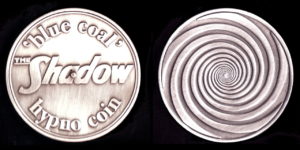
There were, however, some more regional items, but nothing that was offered large-scale. Some Blue Coal dealers had ink blotters made up that promoted their product as well as The Shadow. Of course, since they had the name and phone number of the local coal dealer on them, they were only offered in that one area.
There was an interesting item called a Blue Coal Hypno Coin offered by at least one dealer. Again, it was available locally from your coal dealer, not something you would send away for in the mail. As far as I can tell, the only mail-in premiums distributed by The Shadow were the two rings.
Only two real mail-away premiums. Sad, but true. But what The Shadow premiums lacked in quantity,they made up for in quality. Both the Blue Coal ring and the Carey Salt ring were made of glow-in-the-dark plastic. And for a mail-away premium, that was the mark of quality. You could actually see it in the dark. You could identify yourself to your friend in pitch blackness. You could flash secret messages to your pals using a dot-dash method of flashing the ring, then hiding it behind your other hand. There was no end of fun and adventure you could have, if you were the proud possessor of a Shadow ring.
The Shadow and mail-away premiums went together like ham and eggs… like Abbott and Costello. It was a natural pairing. What about mail-away items available from The Shadow pulp magazine, you may ask? They had their share of membership pins, rubber stamps and the like. But that’s a whole different subject, and one for some other day. For today, let’s remember the premium rings given away on the radio.
If you were the first kid on your block to have one those terrific glowing rings, you were the envy of all the other guys. You had status; you were the first! And you can be sure they would be clamoring after their folks to send away for one, tomorrow!
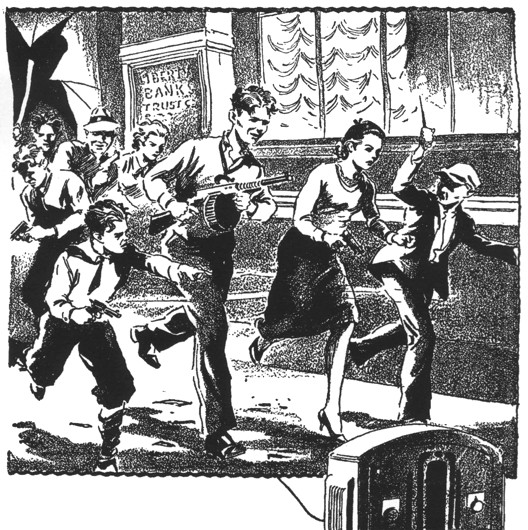

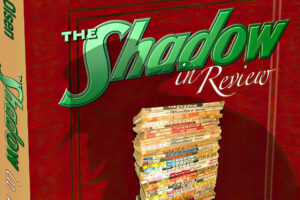
The first ring looks great! The crocodile ring, not as much. Both were news to me, however. Thanks for the story!
The first ring actually looked like a Shadow ring. The figure of The Shadow was embossed on the sides. Right below the “blue coal” stone was printed “The Shadow” on the front and “Blue Coal” on the back. To kids who were showing off their ring to other kids, there was no doubt what ring this was.
The “Carey Salt” ring, however, was not so obviously marked. If you didn’t already know it was a Shadow ring, there was no clue on the ring itself. It was just a ring with open-mouthed crocodiles and a black stone. Poorly planned out, if you ask me. But Carey Salt was a regional sponsor, not a national one, and I guess they were on a budget. So they get points for at least producing a premium give-away. But they lose points for design.
Some Shadow sponsor, somewhere along the line, should have produced a Shadow decoder badge. Even though decoders were aimed at kids, and The Shadow’s was aimed at adults, it still would have been so cool. A Shadow decoder. Ah… we can only dream…
As ‘I’ or any true Shadow fan ‘would’ know, The Shadow’s code was an emphasis on ‘certain’ words during the broadcast. My friend ‘Lee’ said he ‘like’d listening to old episodes of The ‘Shadow’ to see if the emphasis method of transmitting codes had the ‘ring’ of truth.
The Shadow also used invisible ink. I think
if it works.
‘I’ ‘would’ ‘certain’ ‘Lee’ ‘like’ a ‘Shadow’ ‘ring’ – emphasis…
The Shadow was also known for wearing a girasol opal ring that he often used to hypnotize people. In the pulps he got the opal from a mysterious South American tribe.
The girasol ring was never specifically mentioned in the radio series, although in my own mind I can imagine him wearing it, even if it wasn’t mentioned. Boy, wouldn’t that have made a wonderful mail-away premium!
In the pulps, the ring was originally said to have originated from the Romanoff collection of jewels. In later stories, author Walter Gibson said it was given to The Shadow by the Xinca Indians. In the 1970’s, Gibson explained the apparent contradiction by saying there were -two- girasol stones, both originally used as eyes of a Xincan idol. One was stolen and eventually made its way into the Romanoff collection and was eventually given to The Shadow. The other was given him directly by the Xincas.
Or at least that’s the way Gibson explained it away long after the pulp series had ended. Sure, I guess I’ll buy that…